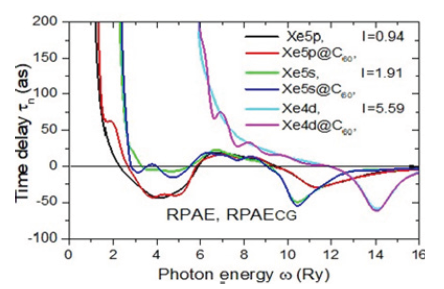- Submissions

Full Text
Determinations in Nanomedicine & Nanotechnology
Role of Fullerenes Shell in Time Delay of Photoelectrons from Endohedrals
Amusia M Ya1,2 and Chernysheva LV2*
1The Racah of Physics, The Hebrew University of Jerusalem, Jerusalem 91904, Israel
2A. F. Ioffe Physical-Technical Institute, St. Petersburg 194021, Russian Federation
*Corresponding author: Chernysheva LV, A. F. Ioffe Physical-Technical Institute, St. Petersburg 194021, Russian Federation
Submission: June 13, 2022;Published: June 22, 2022

ISSN: 2832-4439 Volume2 Issue5
Opinion
In this work we investigate the time delay of photoelectrons by the fullerenes shell in endohedrals. We present the general formulas in the frame of the Random Phase Approximation with Exchange (RPAE) applied to the endohedrals A@CN., that consist of an A atom located inside a fullerenes shell consisting of N carbon atoms C. We calculate the time delay of electrons that leave the inner atom A in course of A@CN photoionization. Our goal is to find out the role played by the CN shell. We considered Ne, Ar, Kr and Xe as specific examples of A, and we consider C60 as fullerene. The presence of the C60 shell manifests itself in powerful oscillations of the time delay τn(ω) of an electron ionized from a given n subshell by a photon with energy ω. Calculations are performed for the outer, subvalent and d-subshells. The time delay of the photoionization process τn as a function of the photon energy ω in atomic units is related to the amplitude phase fn(ω) of the process under consideration by the following relationship [1]. The phases, their energy derivatives, and partial cross sections were obtained in RPAE for an isolated atom and in RPAE taking into account the static C-potential of fullerenes and the dynamic polarization G, denoted as RPAECG [2]. (Figure 1) shows the results of calculations for the Xe atom and Xe@C60 endohedral. Note that the variation of the time delay is much stronger than the change in the partial cross sections. The dipole photoionization of the nl subshell makes it possible to obtain only phase differences from the experiment. The time delay depends on the phase itself, thus providing in principal new information about the photoionization amplitude.
Figure 1:Time delay for 5p,5s,5d subshell of Xe and Xe@C60.

References
- Amusia MY, Chernysheva LV (2020) Time delay of photoionization by endohedrals. JETP Letters 112: 219-224.
- Amusia M, Chernysheva L, Yarzhemsky V (2012) Handbook of theoretical Atomic Physics, Data for photon absorption, electron scattering, and vacancies decay. Springer Publishers, USA.
© 2022 Chernysheva LV. This is an open access article distributed under the terms of the Creative Commons Attribution License , which permits unrestricted use, distribution, and build upon your work non-commercially.
 a Creative Commons Attribution 4.0 International License. Based on a work at www.crimsonpublishers.com.
Best viewed in
a Creative Commons Attribution 4.0 International License. Based on a work at www.crimsonpublishers.com.
Best viewed in 







.jpg)






























 Editorial Board Registrations
Editorial Board Registrations Submit your Article
Submit your Article Refer a Friend
Refer a Friend Advertise With Us
Advertise With Us
.jpg)






.jpg)














.bmp)
.jpg)
.png)
.jpg)










.jpg)






.png)

.png)



.png)






